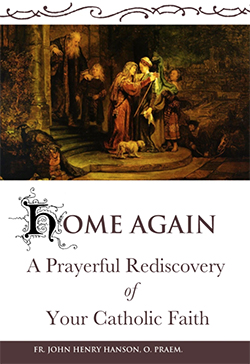A Guide to Revitalizing Your Catholic Faith
“Knowing ‘the temple that we are’ immediately clarifies our keep and discard list, our agenda, our hopes and loves.”


A new book encourages Catholics to live more fully this true identity as they recognize in prayer how God has guided them in life and how he strengthens them through the Catholic faith and sacraments.
In his book, Home Again: A Prayerful Rediscovery of Your Catholic Faith, Norbertine Father John Henry Hanson takes readers seeking to revitalize their Catholic faith on a prayerful journey home, beginning with their own life story followed by visits with the Most Holy Trinity, the sacraments, the Blessed Mother and St. Joseph.
A seminary formator, retreat master and chaplain at St. Michael’s Abbey in Silverado, California, Father Hanson gently and practically guides readers on a meditative journey with Scripture, teaching, anecdotes, and many insights from saints and writers such as St. Josemaría Escrivá, Hubert van Zeller, St. John Henry Newman, St. John of the Cross and St. John Paul II.
In a chapter on baptism and Christian identity, he describes spiritual childhood as the beginning and end of Christian identity. Jesus’ demands in the Gospel may seem jarring, Father Hanson writes, but the saints also startle us in their teaching on the truths of the faith:
“Until a holy person comes along and embodies the gospel, its radical demands might suffer the fate of a museum piece: safe under glass, to be admired but not handled.”
Writing about the Holy Spirit and prayer, Father uses the analogy of a household, especially familiar in this time of COVID-19, to describe how the Holy Spirit dwells in our soul:
“Grasping this truth is the fruit of patiently staying at home, waiting on the Lord. It might mean sitting in an interior that is very plain, or very messy, or even in need of major repair and renovation, listening to the clock tick and the foundation settle as your background music. But it is God’s house, the place where, however humble, his glory dwells (see Psalm 26:8) — and which he purchased at the greatest cost to himself.”
Father Hanson further describes the idea of a spiritual homecoming: “Knowing ‘the temple that we are’ immediately clarifies our keep and discard list, our agenda, our hopes and loves. Instead of hacking through an inner jungle of frustrations and regrets, of misplaced desires and cynicism, we follow the Spirit’s lead along a way we never would have discovered on our own, and which leads to the fullness of life.”
As he helps readers see the sacraments in a new light, Father shares stories of the God’s mercies. Writing about the Sacrament of Reconciliation, he offers: “God sinks to his hands and knees before us and takes responsibility for cleaning off the soil we have put there, and in Jesus’ eyes, This means you belong to me. When you let me do this for you, you belong to me. Do we understand this?”
While guiding readers to seek renewal in their faith, Father Hanson also addresses loneliness, the Blessed Mother’s protection — even for those who have little devotion to her and St. Joseph as a model for following in trust without knowing the outcome.
In the book’s conclusion, he notes that on spiritual journeys such as this, we may end up where we started. But if we’ve allowed God to strengthen our Christian identity, the location will probably look different, Father said. “Home hasn’t changed, any more than the Church changes into something it never was before; but we have changed.”
- Keywords:
- spirituality
















